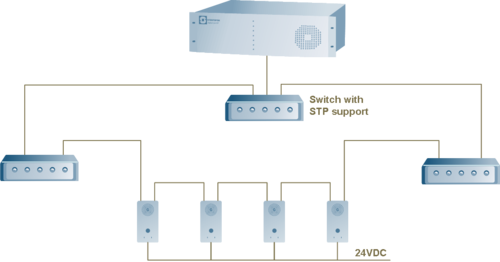Daisy chaining of IP Stations
From Zenitel Wiki
Daisy chain
The IP stations have a built-in two port switch. The ’AUX’ port can be used to connect a second IP station, and to the ’AUX’ port of the second station can be connected to a third station. Up to 10 IP stations can be daisy chained in this way.
Note that the AUX port does not provide power (PoE). The station connected to the AUX port must be powered from a local 24 VDC power supply.
Loop configuration using the spanning tree protocol
- Spanning-Tree Protocol (STP) is a link management protocol that provides path redundancy while preventing undesirable loops in the network. For an Ethernet network to function properly, only one active path can exist between two stations.
- To provide path redundancy, STP defines a tree that spans all switches in an extended network. STP forces certain redundant data paths into a standby (blocked) state. If one network segment in the Spanning-Tree Protocol becomes unreachable, or if STP costs change, the spanning-tree algorithm reconfigures the spanning-tree topology and reestablishes the link by activating the standby path
About the number of stations in a chain
The recommended number of maximum 10 stations is based on a number of factors:
Buffer overflow: Even if there is only one call at the time, all stations will transmit data at regular intervals. These data packets are not large, and is not consuming a lot of bandwidth. But the station at the end of the chain (which will get all traffic through its switch) will get a large amount of data frames to handle. When forwarding data frames it is not the frame size that matters, but the number of frames that must be handles per time unit. The buffer size of the switch is limited, and with many stations in chain there is a risk that the buffer can be filled up.
Potential cyclic situations: In the IP station there is a timer which causes the station to reset after some time if it looses communication with the AlphaCom. With a large number of stations in chain in combination with lack of communication with the AlphaCom in approx. the same length as this timer, there might be potential cyclic situations.
Software upgrade: In a daisy-chained system one have to upgrade station by station, because during the upgrade the station will reboot, and the stations behind in the chain will loose communication with the AlphaCom and the TFTP server. An upgrade of the station software in a large system will take considerable time when daisy-chained
Vulnerability: With a large chain of stations the system will be very vulnerable with respect to faulty stations, cable faults etc.
Based on these factors Zenitel can not guarantee that more than 10 stations will work satisfactory. It might be that you can put more stations in the chain and that it will work fine, but this is not a solution approved by Zenitel.


